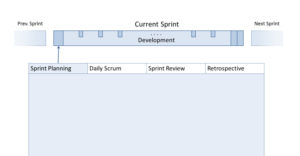Scrum Events Cheat Sheets
Executive Summary: Downloadable PDF cheat sheets you can use to facilitate the meetings of Scrum: Sprint Planning, Daily Scrum, Sprint Review and Sprint Retrospective.
Click here to download the latest version of the Scrum Events Cheat Sheets
At the link above you can download the cheat sheets I use in my Scrum practice. The cheat sheets aim to help you facilitating Scrum events (“meetings”). If you lack experience as a Scrum Master, this can give you enough confidence to start with Scrum. If you have formidable experience with Scrum, you can use the sheets as a reminder of the most important items you might want to touch during an event.
This is the flavor of Scrum I use and teach most of the time, with some tools and techniques you might or might not use. Feel free to modify it to what fits your situation the best.
Some explanations to help you interpret what you see:
- Scrum events: There are five events defined in Scrum [1]. The four meetings detailed in the cheat sheets and the Sprint itself.
- Responsible persons: For every item I write the suggested responsible person(s) in blue. Being responsible for an action means to ensure that the action is carried out. It does not mean that the given person has to perform the task alone.
- General responsibilities:
- Make sure that the Scrum events happen: Scrum Master
- Keep the events within the time box: Scrum Master
- Make sure that the Product Backlog is refined by the time of the Sprint Planning. Invite for Refinement if needed: Product Owner
- Impediments are actionable and acted upon: Scrum Master
- Scaling: The cheat sheets are compatible with scaled versions of Scrum, e.g. Scrum@Scale or SAFe. For scaled Scrum, the sheets should be modified a bit by keeping in mind the scaled artifacts (e.g. higher level backlogs, if any) and scaled roles (e.g. Chief Product Owner, SAFe Product Manager, …).
- Buffer: This refers to the “interrupt buffer” (or “maintenance and support buffer”) auxiliary Scrum pattern. The Buffer is a capacity reserve kept solely to be able to react on unforeseen (at the moment of the Sprint Planning) and thus unplanned topics which need immediate attention, i.e. which have higher priority than the other Sprint Backlog Items. These are tasks like critical bug-fixing, infrastructure fixing, user support, etc…
- Planning Poker: The sheets reflect my personal preference to do Planning Poker with physical cards. There are other methods and tools that could work just as well for you.
- Kaizen: A single improvement action on the way the team works, that will be in the focus of the Team during the Sprint.
- Satisfaction Metric: I use standard Uno cards for recording the individual and team satisfaction. Meaning of the numbers: 5 – OK, 1 – Nothing stops me from quitting tomorrow, 9 – I’m actively pushing my friends and family to join the team/company. 1 — 3: Not satisfied, 4 — 6: OK, 7 — 9: Satisfied. Note: You shouldn’t handle the Satisfaction Metric as it would be some objective metric — it is very subjective by nature. But it’s a great conversation starter for the Retro.
- Scrum Board: This can be any well-visible, single or multiple information radiator(s), like a physical Scrum Board, a virtual board in a project management system or a simple shared text file on a wiki system.
This post has been updated. See the newer version here.
[1] Jeff Sutherland, Ken Schwaber, The Scrum Guide; Link




No Comments